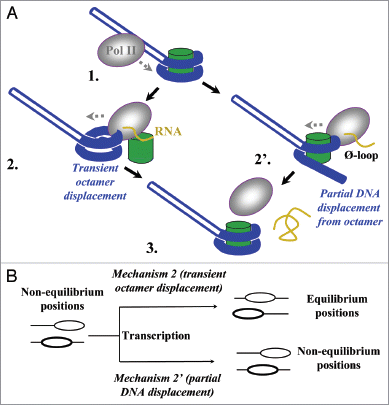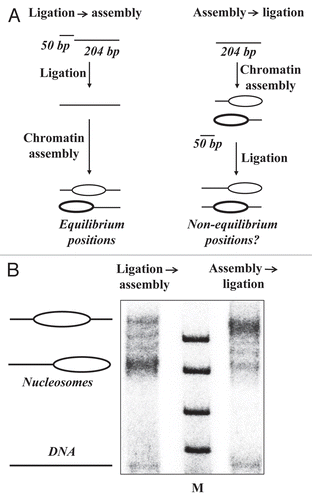Figures & data
Figure 1 The experimental strategy for analysis of the mechanism of nucleosome survival during Pol II transcription. (A) Two possible mechanisms of nucleosome survival during transcription by Pol II.Citation21 After Pol II approaches the nucleosome (1) and partially displaces proximal nucleosomal DNA,Citation20 the octamer could either be completely (2) or partially (2′), transiently displaced from DNA. In the first case octamer re-binds to DNA released behind the enzyme when Pol II proceeds further (3). In the latter case transcription through the nucleosome proceeds without even transient complete dissociation of the octamer from nucleosomal DNA. Histone octamer, DNA and RNA are shown in green, blue and yellow, respectively. (B) The expected outcomes of transcription through a non-equilibrium population of mononucleosomes by Pol II. Transient histone octamer displacement (mechanism 2) would result in equilibration of nucleosome positions on DNA after transcription. In contrast, non-equilibrium position(s) of nucleosomes would be preserved if the octamer is never completely displaced from DNA (mechanism 2′).

Figure 2 Nucleosomes occupy non-equilibrium positions before transcription by Pol II. (A) The experimental approach for analysis of the mechanism of nucleosome survival during transcription by Pol II. In previous transcription experimentsCitation14 nucleosome assembly on the 204-bp DNA fragment was conducted before ligation to the promoter-containing 50-bp fragment and transcription (on the right). To evaluate whether after such assembly → ligation nucleosomes occupy equilibrium positions on DNA, nucleosomes were assembled after ligation (ligation → assembly, on the left). In this case nucleosome positions are equilibrated during the process of assembly. (B) Nucleosomes were assembled before or after ligation to the promoter-containing DNA fragment by dialysis from 2 M NaCl and analyzed by native PAGE.Citation14 In the latter case nucleosome positions are equilibrated during reconstitution. Nucleosome mobility in the gel is dictated by nucleosome positioning on the 254 bp DNA fragment. Since nucleosomes occupy different positions after assembly before (right lane) and after ligation (left lane), nucleosomes occupied non-equilibrium positions before transcription by Pol II.
